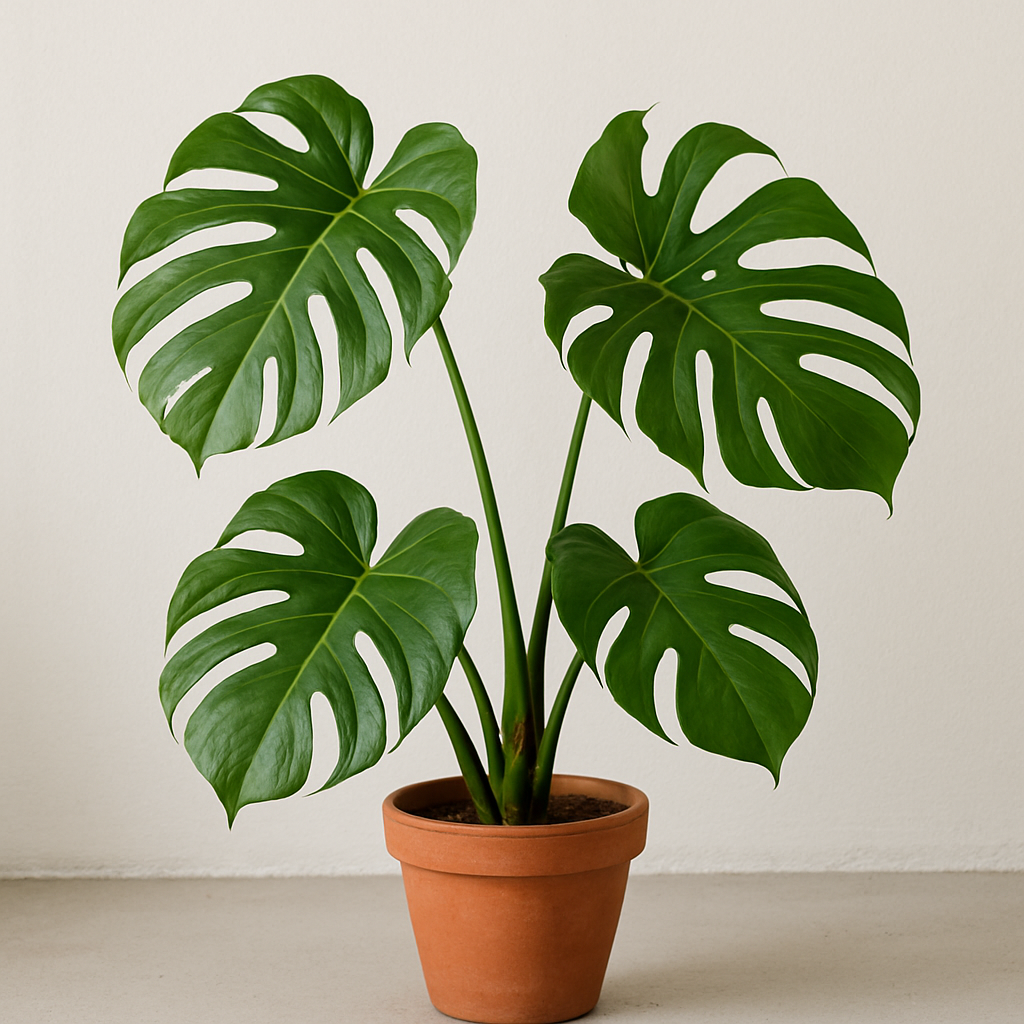The Monstera deliciosa, also known as the Swiss Cheese Plant or Costela-de-Adão in Portuguese, is one of the most iconic and beloved houseplants in interior design. With its large, glossy, and deeply cut leaves, this tropical beauty brings a bold and stylish look to any room while being surprisingly easy to care for.
In this post, we’ll explore everything about the Monstera deliciosa — its origin, characteristics, care tips, propagation methods, and how to keep it thriving indoors.
Origin and Features of the Monstera Deliciosa
Native to the tropical rainforests of Central America, particularly Mexico and Guatemala, the Monstera deliciosa is a climbing plant that uses aerial roots to attach to trees and grow upward in search of light.
The plant’s scientific name reflects two key traits:
- “Monstera”: for its large and unusual leaf shapes.
- “Deliciosa”: referring to the edible fruit it produces in the wild.
Its huge, dark green leaves have distinctive splits and holes, giving it the nickname Swiss Cheese Plant. When grown indoors, it adds a dramatic, sculptural element to the space.
Why Monstera Deliciosa Became So Popular
In recent years, Monstera has exploded in popularity among plant lovers, interior designers, and even influencers. Here’s why:
- Eye-catching, tropical foliage
- Low maintenance and beginner-friendly
- Tolerates a range of indoor conditions
- Symbol of modern, urban jungle decor
- Commonly featured in art, textiles, and home decor
Whether placed in a living room corner, on a plant stand, or next to a window, the Monstera always grabs attention.
How to Care for Monstera Deliciosa
🌞 Light
Monstera thrives in bright, indirect light. It can tolerate some shade, but low light may slow its growth and cause smaller, less fenestrated (split) leaves. Avoid direct sunlight, which can scorch the leaves.
💧 Watering
Water when the top 2–5 cm (1–2 inches) of soil feels dry. Overwatering is a common mistake — soggy soil can lead to root rot. Always ensure the pot has good drainage holes.
🌱 Soil
Use a well-draining potting mix rich in organic matter. A blend of peat, perlite, orchid bark, and compost works well. Good aeration is key for healthy roots.
💨 Humidity
As a tropical plant, Monstera prefers high humidity. It tolerates normal indoor levels but thrives with regular misting or a humidifier, especially in dry climates or during winter heating.
🌡️ Temperature
Ideal temperature range: 18°C to 28°C (65°F to 82°F). Avoid cold drafts and frost, which can damage the plant.
Pruning and Maintenance
Prune your Monstera to shape it or control its size. Use clean scissors or pruning shears to trim yellow, damaged, or overgrown leaves. Cut just above a node (where leaves attach to the stem).
You can also use a moss pole or stake to train your Monstera to grow upright.
How to Propagate Monstera Deliciosa
Propagation is easy through stem cuttings:
- Cut a stem segment with at least one node and one leaf.
- Let the cutting callous for 1–2 days.
- Place it in water or directly in moist potting mix.
- Keep in a warm, bright location.
Roots usually form within a few weeks. Once established, transplant to a larger pot if needed.
Growing in Pots vs. Outdoors
Monstera can be grown in large pots indoors or in shaded areas outdoors in tropical and subtropical climates. Indoors, use a large container with good support, as the plant can grow quite tall (up to 2 meters or more).
Repot every 1–2 years to refresh the soil and allow for root expansion.
Common Problems
- Yellow leaves: Usually due to overwatering. Check for soggy soil.
- Brown leaf tips: Low humidity or underwatering.
- No holes in new leaves: May be due to low light or a young plant.
- Pests: Watch for spider mites, mealybugs, or scale. Use neem oil or insecticidal soap for treatment.
Fun Fact: Monstera Fruit
In its natural habitat, Monstera produces a fruit known as ceriman, which tastes like a mix of pineapple and banana. While edible when ripe, the unripe fruit can be toxic and should never be consumed unless fully matured — and note, this fruit is rarely produced indoors.
Final Thoughts
The Monstera deliciosa is a perfect houseplant for those who want to add a dramatic, tropical flair to their home without too much fuss. Its unique leaves, rapid growth, and resilience make it a favorite in homes and offices alike.
Whether you’re a beginner or a seasoned plant lover, Monstera is a rewarding and stylish addition to any space.

Everything You Need for a Beautiful Garden
Get the ultimate 10-Piece Stainless Steel Garden Tools Set with non-slip ergonomic handles and a convenient tote bag. Perfect for planting, pruning, and weeding – ideal for gardening lovers of all levels. A thoughtful gift for both women and men!
Shop Now on AmazonDiscover the Majestic Guapuruvu Tree
Learn about the Guapuruvu, one of Brazil’s fastest-growing and most impressive native trees. Explore its unique beauty, ecological role, and why it’s treasured in landscaping and reforestation projects.
Read More
